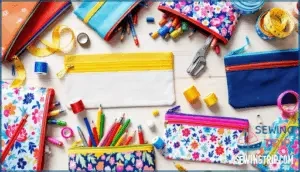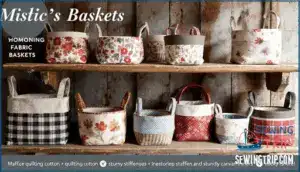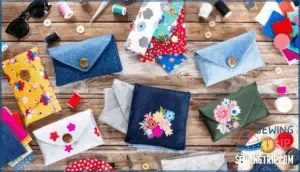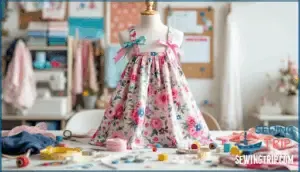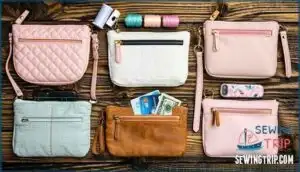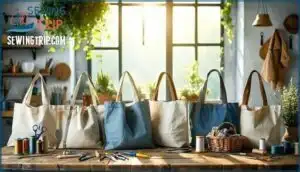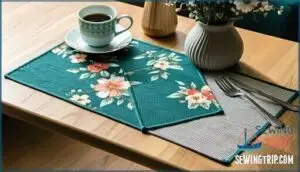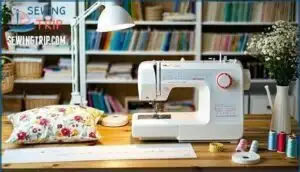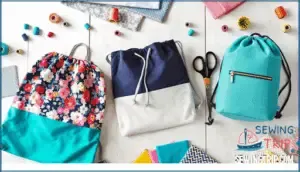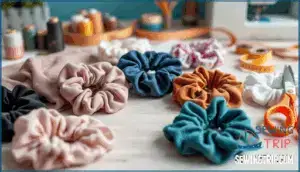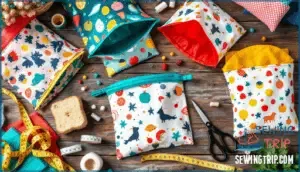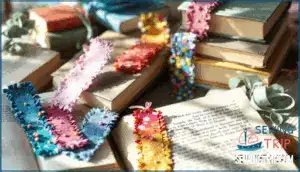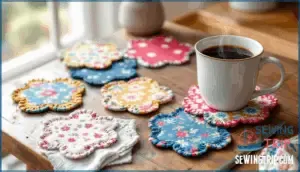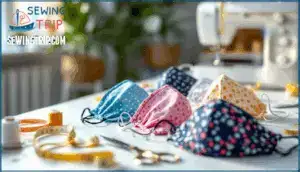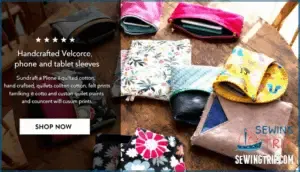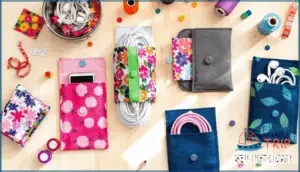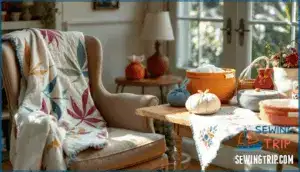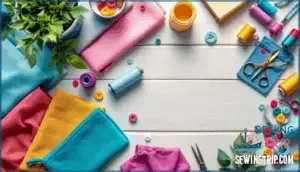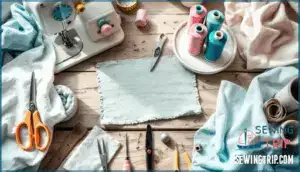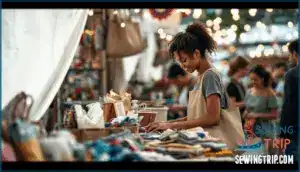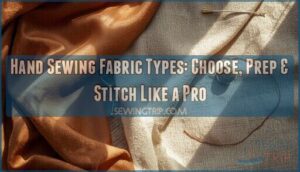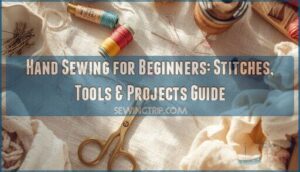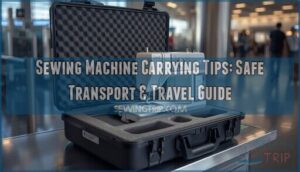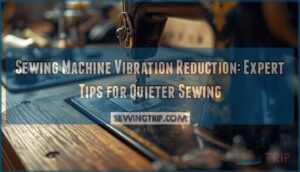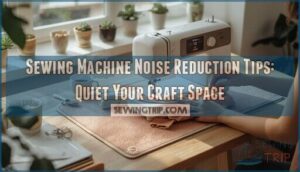This site is supported by our readers. We may earn a commission, at no cost to you, if you purchase through links.
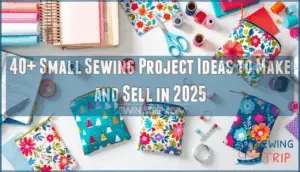
The ideal situation comes from choosing items people actually need—like reusable sandwich bags or phone sleeves—rather than things that just look cute.
You’ll find over forty project ideas here that beginners can master quickly, along with the exact tools you need and the best places to turn your handmade goods into steady sales.
Table Of Contents
Key Takeaways
- You can start a profitable sewing business with small, quick projects like zipper pouches and tote bags that cost just a few dollars in materials but sell for $15 or more online.
- The most successful items solve real problems people face (like reusable sandwich bags or phone sleeves) rather than just looking cute, so focus on useful goods that customers actually need.
- Selling platforms like Etsy, craft fairs, and social media each have different advantages—Etsy reaches millions of buyers, local markets build personal connections, and Instagram showcases your work to build brand loyalty.
- Your startup only needs $100–$300 to launch, and success comes from mastering basic sewing skills (thread tension, seam allowances, pressing), choosing the right fabrics for each project, and pricing smartly using cost-plus methods.
Best Small Sewing Projects to Sell
If you’re looking to turn your sewing skills into extra income, starting with small projects is the smartest move. These items are quick to make, don’t require much fabric, and sell well both online and at local markets.
Here are some of the best small sewing projects that consistently attract buyers.
Zipper Pencil Pouch
A zipper pencil pouch is your go-to beginner project when you want to create something quick, useful, and impressive in under an hour. Here’s what makes these sewing projects to sell so profitable:
- Zipper types let you experiment with metal or nylon options
- Lining options add durability and a professional finish
- Size variations work for pencils, makeup, or travel essentials
- Customization ideas include appliqués, embroidery, or patchwork
- Bulk production becomes easy once you master the technique
Parents and students love this small sewing project for back-to-school season, making it one of the easiest crafts to sell year-round.
Fabric Basket
Once you’ve mastered pouches, fabric baskets let you tackle a three-dimensional project that organizes everything from toys to bathroom supplies while looking cute on any shelf.
You’ll explore fabric choices like quilting cotton or canvas, experiment with stiffening methods using interfacing, and add grip options for easy carrying.
Size variations and lining techniques make these small sewing projects customizable for any customer, turning simple fabric baskets into profitable sewing projects to sell at craft fairs or online.
Sunglasses Case
Protect your favorite shades from scratches and smudges with a sunglasses case that you can whip up in about 30 minutes using just a few scraps of fabric and some soft interfacing. You’ll pick case materials like cotton or felt, add a soft lining fabric for protection, and choose from closure options like snaps or magnets.
Pattern variety lets you customize sizes for different frames, and simple embellishment ideas like embroidery or appliqué turn these small sewing projects into handmade gifts that boost your craft business while sewing for profit.
Girls Pillow Dress
Turn an old pillowcase into an adorable dress that’ll have your little one twirling around in no time—this Girls Pillow Dress takes about an hour to sew and needs just a standard pillowcase, some ribbon, and basic stitching skills.
Fabric choices range from bright cottons to soft florals, and you can try dress variations with ruffles or pockets. Add embellishment options like lace trim or appliqué flowers to make each piece special.
Sizing guides help you adjust armholes and length, while simple sewing techniques keep these small sewing projects perfect for making money sewing as part of your small business ideas for sewing for profit.
Wristlet Purse
A Wristlet Purse gives you hands-free convenience without sacrificing style—perfect for quick trips when you only need your phone, cards, and keys.
Choose fabric choices like quilted cotton or faux leather, add a zipper or snap for closure types, and include interior pockets for organization.
Adjustable strap options and customizable wristlet size make these bags and purses quick sewing projects for profit that turn small sewing projects into a thriving craft business.
Tote Bag
Tote bags might be the most practical sewing project out there—they work for groceries, books, beach trips, or just about anything you need to carry.
You can customize tote bag sizes based on what sells best in your area, experiment with fabric selection like canvas or linen, and try different strap styles for comfort.
Market demand stays strong year-round, making these easy sewing projects reliable money-makers for your craft business when selling crafts online.
Reversible Placemats
Reversible placemats give you two looks in one, so you can flip them based on your mood or the season without sewing double the work. Play around with fabric combinations like cotton prints paired with solid colors, and focus on edge finishing techniques like binding or topstitching to make them look polished.
These kitchen sewing projects sell well as craft fair items because shoppers love practical home goods they can actually use every day.
Envelope Pillow Case
You can whip up an envelope pillowcase in under 30 minutes, and it’s one of those rare projects where "fast and easy" doesn’t mean boring or flimsy. The easy closure on the back means no zippers or buttons, so it’s perfect for quick gifts or building up inventory for your sewing business.
Try different fabric choices and size variations to match any style, and add custom embellishments like piping or monograms to turn these easy sewing projects into bestsellers.
Drawstring Backpack
Drawstring backpacks are like the Swiss Army knife of sewing projects—they work for kids heading to school, adults hitting the gym, or anyone who needs a lightweight bag that folds flat when not in use. You can customize these easy sewing projects with different fabric choices and cord options to create something totally unique:
- Mix cotton prints with canvas bottoms for durability where it counts most
- Try paracord or flat webbing instead of basic drawstring cord for a modern look
- Add interior pockets or exterior zippered compartments to boost functionality and justify higher pricing
Size variations let you target different markets, from small kids’ bags to roomy adult versions.
Beginner-Friendly Scrunchie
If you’ve never touched a sewing machine before, scrunchies are your perfect starting point—they’re nearly impossible to mess up and take less time to make than brewing your morning coffee.
With just a fabric strip and some elastic, you can create easy crafts to sell that look professional. Try velvet, satin, or cotton prints for different looks, then add small embellishments like ribbon or buttons to justify higher prices for your sewing business.
Easy Reusable Sandwich Bag
Reusable sandwich bags check two boxes at once—they’re eco-friendly projects that parents and lunch-packers will buy on repeat because they actually solve a problem.
You’ll want food-safe linings like nylon or PUL paired with cute cotton prints, and snap or Velcro closure options make them washable and practical.
Custom sizing lets you use up fabric scraps while creating small sewing projects that turn into steady income for your sewing business.
Fabric Bookmark
Book lovers will snap up fabric bookmarks faster than you can finish hemming them, especially when you add ribbons or beads for that handmade charm. Here’s what makes these sellable fabric bookmarks winners for your craft business:
- Bookmark Materials like cotton scraps and elastic loops cost pennies per piece
- Bookmark Designs can match popular book genres or seasons for targeted appeal
- Bookmark Packaging with clear sleeves turns small sewing projects into gift-ready items
- Selling Bookmarks on Etsy works great since readers buy in sets for their book clubs
They’re perfect for gifting bookmarks to teachers and librarians, which means steady orders for your sewing business year-round.
Fabric Coaster
Fabric coasters soak up water rings and compliments in equal measure, taking about 10 minutes each to whip up from those scraps you’ve been hoarding.
Layer cotton with batting for absorbency testing results that protect tables without looking boring, then cut coaster shapes like hexagons or circles to stand out at craft fairs.
Bulk production of these 10-minute fabric coasters keeps your online craft business stocked between bigger small sewing projects.
Face Masks
Face masks have transitioned from emergency sewing to steady sellers, and they continue to be in demand as people seek stylish options that fit well. Breathable materials like cotton quilting fabric and elastic ear loops are essential, along with optional mask filters for added protection.
Focus on mask comfort by incorporating adjustable features and nose wires. List these fabric face masks in your online craft business alongside other small sewing projects that consistently sell.
Phone and Tablet Sleeves
Your customers want to protect their gadgets without spending a fortune, and a custom phone or tablet sleeve is the perfect solution. Focus on sizing considerations for different devices and use quilted cotton or felt for interior padding. Add zippers or Velcro for closure options, and don’t forget pattern customization with fun prints.
These phone sleeves are quick projects to sell on Etsy or your online shop, and they’re perfect for anyone who wants to sew and sell practical tech accessories.
Cord Organizers
Tangled cords are the junk drawer of the tech world, but a simple fabric organizer can wrap them up in style. Use snaps or Velcro for closure types, and customize sizes for earbuds or charging cables.
These easy sewing projects sell fast because everyone needs them, making cord organizers a smart addition to your sewing business lineup.
Profitable Sewing Ideas for Gifts and Home
Handmade gifts and home items never go out of style, and they’re perfect for building a loyal customer base.
These projects work great for seasonal markets, housewarming gifts, or everyday essentials that people actually use.
Let’s look at some crowd-pleasers that are both fun to make and easy to sell.
Simple Potholders
Everyone needs a good potholder in the kitchen, and handmade ones bring charm that store-bought versions just can’t match. Simple potholders work great as easy sewing projects for beginners because they’re quick to make and always useful. You’ll want heat-resistant batting inside and sturdy fabric choices like cotton on the outside.
Try these quilting techniques to level up your potholders:
- Simple square quilting for classic style
- Diagonal stitching for extra durability
- Patchwork designs using fabric scraps
Add hanging loops so they’re ready to display, and bundle them into gift sets that fly off the shelves.
Infinity Scarf
An infinity scarf is like a hug you can wear all day, and it’s one of the easiest ways to turn a simple piece of fabric into something cozy and stylish. Choose soft knits or fleece for seasonal scarf trends that customers love.
An infinity scarf transforms a simple piece of fabric into something cozy and stylish that hugs you all day long
This easy sewing project requires minimal sewing skills—just stitch two fabric edges together and turn it inside out.
Try bulk material sourcing to make multiple scarves at once, and you’ll have projects to sell that practically fly off the table at craft fairs.
Easy Beanie Hat
Beanies are one of those goldmine projects that practically sew themselves—just a few straight seams and you’ve got a cozy hat that keeps heads warm all winter long. Use stretchy knit fabrics for the best fit, and don’t be afraid to play around with pattern variations like slouchy styles or cuffed edges.
Add fun embellishment ideas like pom-poms or patches to make your easy beanie hat stand out, and you’ll have handmade gifts that customers can’t resist grabbing off your table.
Cloth Napkins
If you want to bring a touch of elegance to everyday dining without breaking the bank, cloth napkins are your answer—they’re simple squares of fabric that turn into polished table settings in minutes.
Choose fabric selection like cotton or linen, experiment with size variations from cocktail to dinner, and master basic hemming techniques for clean edges.
Pattern design options are endless, and you’re helping customers embrace sustainable dining while building your sewing business with these easy kitchen accessories.
Superhero Cape
Kids light up when they pull on a cape and suddenly become superheroes, and you can sew these colorful costume pieces in less than an hour with just fabric, ribbon, and a simple pattern.
Focus on cape design with bright colors, pick soft fleece or cotton for fabric choice, and add Velcro or snap closure options for kid safety.
Custom embellishments like felt letters or stars turn these sewing projects into bestsellers at craft fairs.
DIY Make-Up Remover Pads
Reusable makeup remover pads save money and cut waste, and you can stitch a set of these eco-friendly circles in about 30 minutes using soft cotton flannel or bamboo fabric.
Stack two fabric layers, sew around the edges, and flip inside out for gentle fabric choices that work beautifully in any DIY skincare routine.
You can make different pad size options from leftover fabric scraps, turning small sewing projects into thoughtful gifts or quick sellers at local markets.
Hanging Kitchen Towel
Hanging kitchen towels with a button loop add a pop of color to your space while keeping your dish towels right where you need them. You’ll sew a fabric strip with a button onto the top of a regular dish towel, creating towel hanging styles that work on oven grips or cabinet knobs.
Choose sturdy cotton for fabric durability, and you’ll have easy sewing projects that double as kitchen decor with serious gifting potential.
Reversible Bowl Cozy
These reversible bowl cozies protect your hands from hot bowls and cold dishes straight out of the microwave or freezer. You’ll layer cotton fabric with heat-resistant batting for microwave safety, creating cozy sizes that fit standard bowls. Pick fabric choices that match your kitchen style, and follow simple washing tips to keep these sewing projects looking fresh. These small sewing items practically fly off the shelves at craft markets.
- Heat resistance comes from insulated batting between fabric layers
- Sew and sell sets of three in different sizes for better profits
- Machine washable design means customers can use them daily
- Quick projects to sell that take under an hour to complete
Trending Small Sewing Projects for 2025
The sewing world is buzzing with fresh ideas for 2025, and some projects are flying off the shelves faster than others. If you want to tap into what’s hot right now, you’ll need to know which small items are catching buyers’ eyes.
Here are seven trending projects that combine quick crafting with serious selling potential.
Mini Tote Bags
Mini tote bags are flying off the shelves right now, with top sellers racking up over 1,000 sales each month on platforms like Etsy. People love them because they’re practical for quick errands and fun to customize.
You can sew and sell these small sewing projects with different fabric selection choices and size variations to match what your target audience wants. These projects work great because they’re quick to make and customers can’t get enough of them.
| Feature | Budget Option | Premium Option |
|---|---|---|
| Fabric Crafts | Cotton prints | Organic canvas |
| Customization Options | Simple monogram | Hand-embroidered designs |
| Production Costs | $3-5 per bag | $8-12 per bag |
Retro Prints and Organic Materials
Vintage patterns and organic fibers are shaping small sewing projects in 2025, blending nostalgia influence with sustainable sewing practices. Retro designs from the 1950s are especially popular, and you’ll find earth-inspired color trends like mustards, browns, and greens dominating the market. Upcycling clothes will also be a popular trend, reducing waste and promoting creativity.
Here’s what makes these projects ideal for selling crafts at craft fairs or on Etsy:
- Organic cotton and linen cut environmental impact by nearly 46% compared to conventional fabrics
- Floral and ethnic motifs on retro prints appeal to buyers seeking authenticity
- Upcycle
Fabric Beverage Holders
Fabric beverage holders turn your sewing scraps into cash while keeping drinks at the perfect temperature. You can add insulation options like batting or foam to boost function, then experiment with unique designs that catch buyers’ eyes.
Material costs stay low, and sizing guides help you fit everything from coffee cups to water bottles. Customization ideas like monograms or seasonal prints make these small sewing projects stand out at craft fairs, turning your sewing business into a steady income stream.
Cute Fabric Headbands
Headbands stitch up fast and fly off tables when you pair trendy fabrics with styles that work for both kids and adults. Try twisted tops, knotted bows, or wide bands in retro prints and organic cotton for 2025.
Add elastic for comfort, then price your small sewing projects based on embellishments like buttons or appliqués to boost profits.
Knotted Hairties
A pack of hairties costs a few bucks at the store, but you can make a dozen knotted versions in less than an hour and sell them for way more.
Choose soft knit fabrics in prints that pop, tie a simple knot at the seam, then bundle them in threes for Etsy or craft fairs.
Bulk production keeps costs low while offering variety that shoppers love.
Chapstick Holders
Everyone misplaces lip balm, but your tiny chapstick holders can turn that everyday frustration into a stylish solution people will actually buy. These small sewing projects take minutes to make from fabric scraps and can be made unique with:
- Fun closure options like snaps or elastic loops
- Bright prints that match keychains or bag straps
- Custom holder dimensions for different lip balm sizes
Attach a lobster clasp so customers can clip them anywhere, turning your handmade gifts into impulse buys at craft fairs or part of your thriving sewing business.
Ipad and Tech Cases
Tech lovers pay premium prices for cases that actually protect their gadgets, so sewing padded iPad sleeves and laptop covers can quickly become your most profitable product line.
Use quilted batting and durable case materials for solid device protection, and offer sizing options for different models.
Smart pattern design with secure closures turns these DIY projects into handmade gifts that practically sell themselves at any craft fair.
Essential Tools and Materials for Beginners
Getting started with sewing doesn’t require a massive investment, but having the right basics makes all the difference. You’ll want to focus on quality tools that won’t frustrate you as you learn.
Let’s look at what you actually need to begin making these small projects.
Sewing Machines and Equipment
Your sewing machine is the workhorse that’ll make or break your creative dreams, so choosing the right one matters more than you might think. For starting a sewing business, you don’t need fancy quilting machines or serger machines right away. A reliable basic model gets you going.
Here’s what you’ll need:
- Different needle types for various fabrics
- Extra presser feet for special techniques
- Machine maintenance kit for regular cleaning
- Quality thread in basic colors
- Seam ripper for fixing mistakes
Keep your craft business tools clean and well-oiled, and they’ll serve you for years.
Choosing The Right Fabrics
Cotton fabric is your best friend when you’re just getting started, but knowing which types work for different projects can save you a ton of time and money. Use this quick guide to match fabric types with what you’re making:
| Fabric Type | Best For |
|---|---|
| Quilting cotton | Scrunchies, pouches, coasters |
| Canvas | Tote bags, baskets, wristlets |
| Flannel | Napkins, bowl cozies, pillowcases |
| Fleece | Beanies, scarves, superhero capes |
| Linen blends | Placemats, napkins, home décor |
Pick prints and color palettes that match seasonal trends for your craft business.
Basic Notions: Scissors, Pins, Thread
Once you’ve got fabric picked out, you’ll need a few basic tools that’ll make every project smoother and faster. Sharp fabric scissors are a must—don’t use your regular household scissors or you’ll end up with jagged edges. Straight pins keep everything in place while you sew. Thread weight matters too, so match it to your fabric and needle compatibility.
Ergonomic notions make sewing way more comfortable, especially for DIY projects you’ll sell. These handmade goods need clean finishes, so invest in quality basics.
Where to Find Patterns and Tutorials
Finding the right patterns and tutorials can feel overwhelming at first, but tons of free and paid resources are just a few clicks away. Check out online pattern sites like Craftsy and Bluprint, or browse sewing blogs for DIY tutorials. Your local library has pattern books too.
Many free sewing patterns come with video guides, perfect for starting your crafting business ideas. Mix paid and free sewing tutorials to build skills fast.
Where and How to Sell Your Sewing Projects
You’ve put in the work and now your handmade items are ready to find new homes. The next step is figuring out where to sell them and how to get them in front of buyers.
Let’s look at the best places to showcase your creations and smart strategies to make your sewing side hustle successful.
Online Marketplaces (Etsy, EBay, Amazon Handmade)
Online platforms put your handmade goods in front of millions of buyers without needing a storefront. Etsy remains the go-to marketplace with 95.5 million active buyers, though Etsy seller growth has slowed recently. Amazon Handmade attracts serious shoppers who trust high ratings, while eBay handmade focus centers on sustainable and individual items. eBay is a good option if you want to focus on eco-friendly materials, which are currently in high demand.
Consider these factors when choosing where to list:
- Etsy excels for handmade gifts and craft business launches, despite GMS decline.
- Amazon Handmade rewards sellers with diverse listings and first-rate customer service.
- eBay works well for affordable-luxury and eco-friendly sewing projects.
- Gifting segment drives 44% of Etsy purchases, perfect for seasonal items.
- Mobile shopping accounts for 42% of sales, so refine photos for small screens.
Craft Fairs and Local Markets
Face-to-face selling at craft fairs lets you connect with shoppers who value handmade gifts and want to support local vendors. Small markets with 50 vendors usually draw 500 to 2,000 guests, while larger fairs can bring in 20,000 or more. Booth costs range from $25 at community events to $500 at premium spots, with conversion rates between 10% and 40%.
Personalization—like monograms or custom embroidery—boosts appeal, and eco-friendly materials attract buyers in 2025.
Using Social Media for Marketing
Platforms like Instagram and Pinterest can turn your colorful creations into real business opportunities—no fancy marketing degree required. Post clear photos, use hashtags like #sewingbusiness and #etsyshop, and engage with the craft market community. Here’s your starter plan:
- Platform Selection – Instagram for behind-the-scenes and Pinterest for product inspiration
- Content Strategy – Show your process, finished pieces, and customer reviews
- Audience Engagement – Reply to comments and share tips for creating an income stream
Analytics tracking helps you see what sells best, turning your hobby into a steady income.
Building a Brand and Pricing Strategies
Building a strong Brand Identity isn’t about fancy logos—it’s about telling your story. Around 66% of shoppers care about brand identity when buying handmade goods, so share what makes your sewing business special on Etsy and beyond.
For Pricing Models, try cost-plus pricing: calculate materials, labor, and profit, then double it. Competitive Analysis helps you adjust before busy seasons.
Smart Cost Management and Value Creation through authentic marketing turn your craft into a real income stream, creating an income that lasts.
Frequently Asked Questions (FAQs)
How much startup capital do I need?
You don’t need a trust fund or a second mortgage to start a sewing business.
Most beginners launch with $100–$300, covering material costs, equipment expenses, and a small marketing budget, skipping legal fees until profits roll in.
What are common beginner sewing mistakes to avoid?
Skipping basic sewing techniques can trip you up fast. Don’t rush past learning proper thread tension, seam allowance, and pressing seams—these sewing skills matter.
Practice cutting straight and choosing the right fabric for beginners before diving into complex projects.
How do I calculate fabric yardage requirements?
Figuring out how much fabric you need starts with your pattern layout and the fabric width you’re working with. Most patterns tell you the yardage, but if you’re winging it, measure your pieces, add seam allowances, and factor in any repeat patterns or directional prints to avoid running short.
Whats the best way to package handmade items?
Good packaging protects your handmade items while catching the eye. Use eco-friendly materials like tissue paper and kraft boxes for branding considerations.
Add custom labels or stamps for visual appeal without breaking the bank—cost-effective options that still look professional.
How do I handle custom order requests?
Custom orders require clear client communication upfront about design specifications, pricing custom orders, and managing revisions. Document everything in writing, set realistic timelines for order fulfillment, and use contracts to protect your sewing business while guaranteeing client satisfaction.
Conclusion
Think of your sewing machine as a small business partner that doesn’t take coffee breaks. These small sewing project ideas to make and sell turn your creative spark into real income, one stitch at a time.
You’ve got the project list, the tools, and the selling strategies—everything you need except the decision to start. Pick one project tonight. Cut your fabric tomorrow. By next week, you could be packaging your first sale. The thread between "someday" and "today" is shorter than you think.
- https://www.accio.com/business/top-selling-sewing-projects
- https://threadsmonthly.com/popular-sewing-projects-to-sell/
- https://www.quiltingboard.com/main-f1/craft-show-best-sellers-t143028.html
- https://www.reddit.com/r/quilting/comments/weddch/if_youve_done_a_craft_fair_what_has_sold_the_best/
- https://lowlandkids.com/blogs/news/handmade-clothing-pricing-101-how-to-charge-fairly-and-profit-from-your-creations

